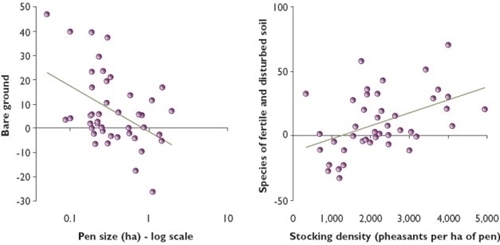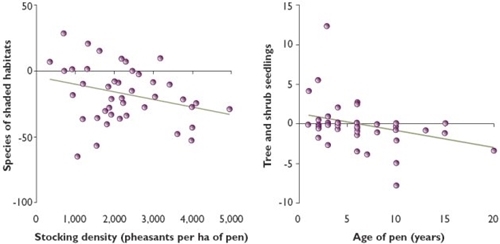Key findings
- The amount of bare ground decreases with increasing size of release pen.
- Plants of disturbed ground increase inside release pens as pheasant densities go beyond recommended levels.
- Species preferring shade decrease in pens as stocking goes up.
- Tree and shrub seedlings decline in older pens.
- These affects can be avoided or reduced by keeping stocking densities at recommended levels (around 700 birds/ha of pen).
- We recommend avoiding putting pens in ancient semi-natural woodland containing valuable native shade-tolerant perennial floras.
In this study we aimed to show whether plant communities in areas of woodland enclosed by pheasant release pens were different to those found in other parts of the same woodland. We did the study in the southern half of England and confined it to ancient semi-natural woodland sites. These woodlands are valuable habitats for wildlife and an important part of our cultural heritage.
We used replicated quadrat surveys of ground flora species and structure in a sample of 43 release pens in ancient semi-natural woodland and 43 (paired) control plots. We did this in spring/early summer, to ensure that any changes detected were not just seasonal (ie. just following release). We also investigated the extent to which any effect might be related to the stocking density of the pen, pen size or pen age.
The sample of 43 release pens ranged from one to 20 years in age. The average pen size was 0.5 hectares and the average stocking density was 2,100 pheasants per hectare of pen. Since 1988 pen sizes may have increased and densities decreased. Overall, the release pens had more bare ground and less vegetative cover from 0 to 10 centimetres off the ground in the spring than the control areas. Bare ground was most evident in smaller pens (see top left graph in Figure 1).
Overall, plants of fertile or disturbed ground (see Table 1) were significantly more common in release pens than control plots. However, these species only increased in percentage cover as stocking density increased above a certain level. At densities below around 1,000 birds per hectare, the establishment of these (sometimes undesirable) species will not occur (see top right graph in Figure 1).
Figure 1: Top left: Amount of bare ground in relation to pen size; Top right: Species of fertile disturbed soil in relation to stocking density; Bottom left: Species preferring shade in relation to stocking density; Bottom right: Tree and shrub seedlings in relation to age of pen


Note: each point represents a separate site. For each graph the vertical axis is the percentage difference between the pen plot and the control plot at a particular site, so positive values mean more of that measure of the ground flora in the pen than in the control and vice versa. Regression lines are all statistically significant at P<0.05.
The release pens, however, had fewer species overall and this was due to a reduction in the percentage cover of shade-tolerant perennials characteristic of old woodland sites (see Table 1). The number of these important woodland plants reduced further as stocking densities went up. At densities below around 1,000 birds per hectare, these effects are minimised, but still occur (see bottom left graph in Figure 1).
Tree and shrub seedlings were not common in most of the pen or control sites in the study. This a problem for many lowland woods, particularly where deer are numerous. Where these seedlings did occur, their abundance was further reduced by the presence of a release pen. This time the reduction was related to the age of the pen (see bottom right graph in Figure 1). Bramble, the most abundant species in the study, was also less common in release pens.
We have documented many of the benefits to woodlands of releasing pheasants in cases where a principal aim of the game manager is to encourage shrubby cover and open areas for pheasants through coppicing, skylighting, ride widening and so on. Although we have identified release pens as a possible source of conflict which, when managed badly, can negate the benefits in sensitive woodlands, the work also indicates that by implementing good practice these conflicts can be avoided.
In particular, we believe it is best to avoid areas of ancient semi-natural woodland containing a valuable native shade-tolerant woodland flora when considering a new pen site. We recommend maintaining stocking densities at recommended levels by restricting the number of birds released, maximising the pen size, or both. We are currently expanding our research to produce detailed recommendations.
Common plants in pens
Table 1: Preferring fertile or disturbed ground
| Plants |
Pen |
Control |
| Creeping thistle |
4 |
2 |
| Cocksfoot |
11 |
6 |
| Cleavers |
16 |
17 |
| Hogweed |
3 |
0 |
| Yorkshire fog |
7 |
3 |
| Annual meadow grass |
14 |
3 |
| Creeping buttercup |
2 |
6 |
| Dock |
9 |
1 |
| Chickweed |
15 |
7 |
| Common nettle |
27 |
22 |
| Lords and ladies |
9 |
14 |
| Yellow archangel |
9 |
18 |
| Wood millet |
2 |
9 |
| Rough meadow grass |
35 |
30 |
Table 2: Preferring shady conditions
| Plants |
Pen |
Control |
| Wood anenome |
11 |
13 |
| Lords and ladies |
9 |
4 |
| False brome |
4 |
7 |
| Pignut |
4 |
3 |
| Wood avens |
6 |
21 |
| Ground ivy |
8 |
22 |
| Ivy |
2 |
4 |
| Bluebell |
27 |
26 |
| Yellow archangel |
8 |
17 |
| Wood melick |
5 |
5 |
| Dogs mercury |
29 |
30 |
| Wood millet |
2 |
9 |
| Wood sorrel |
3 |
7 |
| Lesser celandine |
5 |
6 |
| Wood speedwell |
5 |
8 |
| Dog violet |
6 |
14 |
The numbers are sites from the sample of 43 at which species were recorded in the pen or control area.